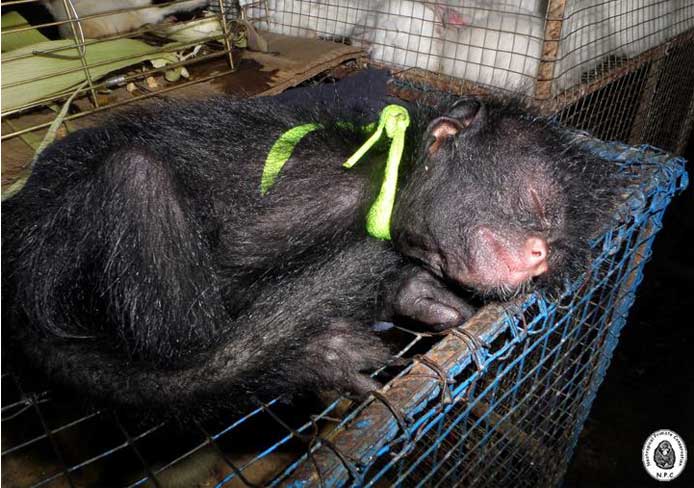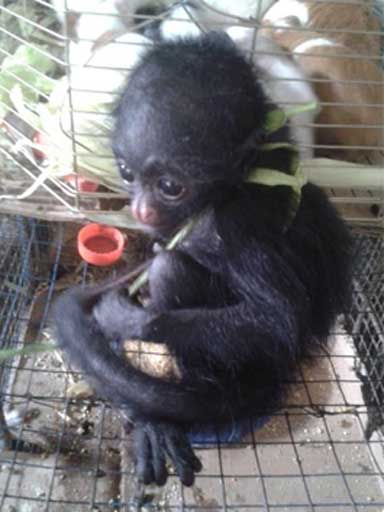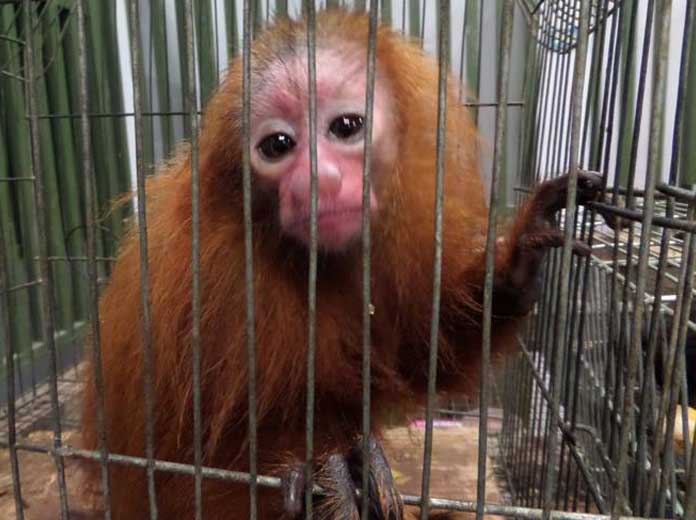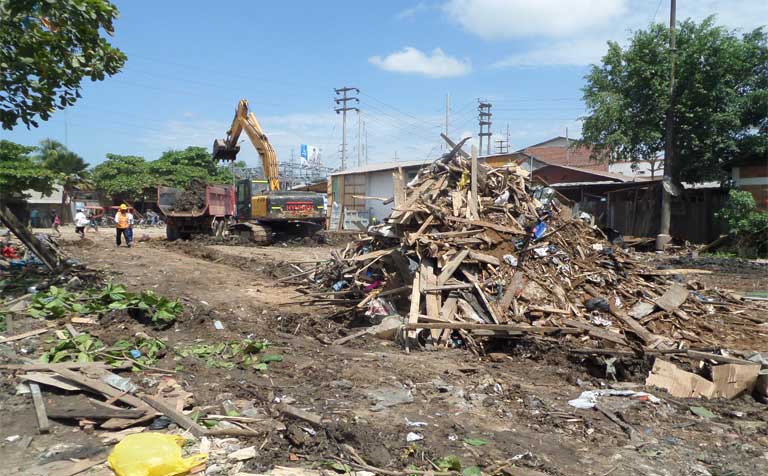- Bellavista market operated for 20 years; wildlife rescue groups and health officials have made repeated pleas to officials since 2007 for it to be shut down.
- Wildlife vendors illegally dealt in dozens of species including the yellow-headed caracara, Amazonian pygmy owl, ocelot, Goeldi’s monkey, green anaconda, and mata mata turtle.
- Wild and domestic species were routinely housed together, increasing disease transmission risks between animals and humans.

A determined collaborative effort between health officials and activists has resulted in the shutting down of one of the most egregious and flourishing illegal wildlife markets in all of Peru. Bellavista Market, after nearly twenty years of illegal activity, was finally not only closed but completely razed to the ground in November.
Veterinarian Patricia Mendoza, together with the Wildlife Conservation Society’s Wildlife Health and Health Policy Program (since 2010, as a part of the USAID-PREDICT project), visited the market located in the city of Pucallpa repeatedly between 2007 and 2012. What Mendoza saw left an indelible impression on her.
“Bellavista was just the worst,” she told mongabay.com. “It always had this pack of animal sellers concentrated in a section of the market, and everybody knew about it. Before the research project, I couldn’t go inside of animal markets without crying or feeling anger. At Pucallpa, I always avoided Bellavista Street. So it was a hard adaptation, harder when I had to explain [to] other members of the crew to [put] their feelings aside to work at the markets.”


At every visit, she and her team introduced themselves as part of a health research project. They returned repeatedly until suspicious vendors eventually allowed them to conduct animal counts, collect some dead animals, and finally, collect samples from live animals for health screenings.
Located at the intersection of Libertad Road and Bellavista Avenue in Pucallpa in Ucayali province, Bellavista was created when an older street market was closed and vendors were encouraged to move into a formal indoor market. The animal vendors, wishing autonomy for what was even then an openly thriving illegal trade in wildlife, refused to move indoors and instead relocated to the Bellavista locale where it did a booming business for 20 years.
In 2013, Mendoza’s team recorded 21 vendors selling live animals, and 13 vendors of wildlife, totaling some 76 exotic species — trade strictly prohibited by Peruvian law.

The team calculated an average of 42 primates were being sold each week, with 1,100 animals sold per week overall. Wildlife species included the yellow-headed caracara (Milvago chimachima), the Amazonian pygmy owl (Claucidum bardyi), ocelot (Leopardus pardalis), Goeldi’s monkey (Callimico geoldii), green anaconda (Eunectes murinus), and mata mata turtle (Chelus fimbriatus).
Wild and domestic species were routinely housed together, increasing disease transmission risks between them and the humans who handled and transported them. Mendoza’s team detected Newcastle disease, an infectious viral avian distemper, in one of every ten chickens; it can spread through a flock in from 2 to 12 days via aerosol transmission according to the Merck Veterinary Manual. Domestic birds in the market exhibited avian respiratory disease, while wild birds were infected with the bacteria Aeromonas hydrophilia, which can cause gastroenteritis. Three of every ten reptiles had Aeromonas hydrophila, which causes infections of the skin and diarrhea in humans.

More startling was the host of diseases detected in the primates at the market, a greater threat to human health due to our shared evolutionary history. The saliva of monkeys showed hemoparasites (causing filariasis and Chagas Disease), Retroviruses (causing encephalitis and immunodeficiencies in primates) and Microbacterias of the tuberculosis complex.
Trading in wildlife, openly and in secret
Noga Shanee, a biologist and activist and co-founder of the NGO Neotropical Primate Conservation in Peru, first set foot in the Bellavista market in 2013.
“It [was] the most open, illegal thing. It’s in the middle of the city. They had hundreds of animals,” she reported to mongabay.com. The animals were housed in atrocious conditions, with the birds caged and the big parrots with wings trimmed so they couldn’t fly. Many animals were sick and near death.

Shanee, who has a special passion for primates, described the unnatural behaviors she saw in these highly social animals sold in the market. “The monkeys were very young,” she recalled. One spider monkey (genus Ateles) was less than one month old, almost completely bald and disoriented. Shanee remember one female woolly monkey (Lagothrix lagotricha) who was about three years old and probably resold by her original owners back to the market — the animal seemed desperate for human touch and very distressed. In a single day, Shanee counted 15 stalls, each with three to four animals, most with parakeets and river turtles. Seeing a hundred of these commonly traded species in a single day was not uncommon at Bellavista. “It was a huge, ugly mafia — very dangerous and very organized,” reported Shanee of the sellers.
Animals seen in the stalls also served as advertisements for larger collections of illegal wildlife stored secretly elsewhere in warehouses around the city. Mendoza’s team found evidence of as many as four such warehouses, but never entered one, because she and her team needed to avoid being a part of government raids in order to gain and keep the trust of the vendors during the health assessment project.
Mendoza reports seeing “important middlemen” at Bellavista, who had come to Pucallpa to illegally purchase animals from the warehouses for major urban wildlife markets in Lima and Chiclayo; these traffickers often markedly altered their behaviors when they observed the health team at work nearby. These same middlemen were also sometimes observed in legitimate local government offices and at zoos — a possible indication of the role corruption and bribery played in permitting the trade to persist unchecked for so long.
When Mendoza’s team assisted in relocating rescued animals away from the market, they often noticed discrepancies between the number of animals confiscated by authorities and the number available for relocation — clearly corrupt officials were allowing some animals to quietly disappear into the shadowy and voracious wildlife trade, she said.
The downfall of Bellavista
How did an obviously illegal market flaunt the law for twenty years? Mendoza described the extreme reluctance of the government to visit the market: “Corruption [in] the forestry service was much stronger [at] that time, and we didn’t have Noga [Shanee] to denounce all of them,” she explained.

Shanee did not participate in the health assessments, and so, did not need to restrain her advocacy. She quickly learned that a buyer only had to enquire about a particular desired rare species to purchase it from a vendor — someone would leave and soon return with the animal.
Shanee participated in several government raids on illegal vendors, accompanying the Fiscalia, the Provincial Environmental Prosecutor appointed to enforce wildlife trade laws. She witnessed terrifying encounters with angry vendors who evaded arrest and who even chased officials away with machetes. On these raids, the officials and Shanee focused on rescuing animals. Arrests were never made. “There were too many people,” Shanee explained. In Peru, it is not uncommon for the public — which often believes that people have a right to own wildlife — to form angry mobs to defend apprehended traffickers.
The end of Bellavista
Destroying the market, which was located on municipal land, was long overdue — twenty years overdue, said Shanee. Initially, she worked with the municipality filing complaints known as denuncias, addressing the illegality of the market. When she had finally mustered sufficient government support, she organized one final denuncia. The Fiscalia agreed to storm the market the next morning and arrest everyone they could — they invited Shanee to be there.

Then the government altered its plans. “I did a [final] denuncia, and they answered that, but they canceled it at the last second,” said Shanee, regret and frustration in her voice. “Instead, they visited the market at midnight, and with heavy machinery they just broke it down.
“They told everyone beforehand, so [all the vendors] knew about it,” she reported — again, no arrests were made.
A new market has since been constructed, into which all registered vendors have been strongly encouraged to move. While this appears to be an incomplete solution, Shanee and Mendoza feel certain the new market will prove to be a major obstacle to wildlife trade.
“The new market is covered, with a single entrance. There’s no way they can openly sell illegal [wildlife],” asserted Shanee.
“In Lima, at least three markets [were] moved from the streets to an enclosed building, and the sales of wildlife dropped,” reported Mendoza. “One of them changed from wildlife to only exotic species, but the other two dropped wildlife entirely and reduced domestic animal trade also”.
Once the vendors are in such a building, they are required to be responsive to government rules, and when one vendor commits a crime, punishment is often applied to the entire market. As a result, legal vendors exert a great deal of pressure and influence on others to obey the law.

“If the system works the same [in Pucallpa], 11 [illegal wildlife] vendors will be nothing against the rest of the people working [in the] markets,” said Mendoza. “It is so hard to see all these animals in markets, that the only thing that kept us working was the sense that the information produced was [going to] serve to move authorities to do something.“
Noga Shanee has been hailed by wildlife advocates as the activist who brought on the demolition of the Bellavista market with her three years of campaigning and animal rescues.
Reducing Bellavista to rubble is no doubt an important step toward combating wildlife trafficking in Peru, said Shanee, and it is thought to be having an immediate and drastic impact on the regional trade. Whether vendors will merely seek to establish new illegal open markets, or the trade will be pushed underground, remains to be seen. What is certain is that the destruction of Bellavista is just one blow against Peru’s robust, illegal, domestic and international wildlife trade.
Citations
Mendoza, P., Cavero, N. 2014. Comercio de Animales Silvestres en el Mercado de Bellavista (Pucallpa, Ucayali) 2007-2012. Documento de Trabajo #26. Wildlife Conservation Society, Lima, Perú.
Corrections 12/18/2015 4:00pm Eastern:
This story originally reported that:
- The team calculated an average of 42 animals were being sold each week.
- Mendoza’s team detected Newcastle disease, an infectious viral avian distemper, in one of every ten ducks.
- Domestic birds in the market exhibited avian influenza, while wild birds were infected with the bacteria Aeromonas caviae, which can cause gastroenteritis.
- The saliva of monkeys showed Flaviviruses (the cause of yellow fever and dengue), Arenaviruses (causing acute hemorrhagic fever), and Retroviruses (causing encephalitis and immunodeficiencies in primates).
Veterinarian Patricia Mendoza requested the following changes and the article has been corrected to read:
- The team calculated an average of 42 primates were being sold each week, with 1100 animals sold per week overall.
- Mendoza’s team detected Newcastle disease, an infectious viral avian distemper, in one of every ten chickens.
- Domestic birds in the market exhibited avian respiratory disease, while wild birdswere infected with the bacteria Aeromonas hydrophila, which can cause gastroenteritis.
- The saliva of monkeys showed hemoparasites (causing filariasis and Chagas Disease), Retroviruses (causing encephalitis and immunodeficiencies in primates) and Microbacterias of the tuberculosis complex.

